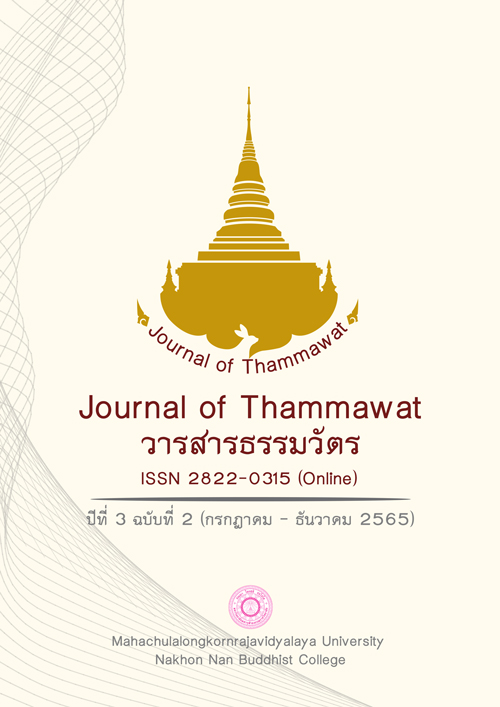Participation of Learning Storytelling in Communication Ban Thademee Ching Karn District Loei Province for Support Tourism Skywalk Loei
Main Article Content
Abstract
The purposes of academic research were to study 1) making stories about the quality of community life Ban Thademee Ching karn District Loei Province 2) storytelling multiple intelligence learning Ban Thademee Ban Thademee. There was cooperative action research. The taget group 50 leaders and citizen in Ban Thademee. The instrument were interview and participation on storytelling multiple intelligence learning. The data were analyzed by frequency and descriptive storytelling multiple intelligence learning. The findings : (1) Thequality of life community Thademee from the verbal telling of the impoverished 100 household. Total population of 367 households, population of 1,089 people, male 515 and female574. There are plain and mountain areas in total 4,000 rai. Is an agricultural area of 2,500 rai. The people were agriculture such as growing rice, vegetables, fruits, handicrafts, weaving.They was wicker and betel plate processing herbs for consumption and distributionto tourists who come to pay homage to the Big Buddha and Skywalk. (2) Storytelling multipleintelligence learning Ban Thademee Ban Thademee Gardner principle informal Thai Loei language and verbal usage patterns. There was content synthesized from a group process from creativity related to the way of life Ban Thademee beliefs and traditions. Learning to adapt to changes for the development of community tourism by reflecting the results of the information and stories in the media, brochures and videos.
Article Details

This work is licensed under a Creative Commons Attribution-NonCommercial-NoDerivatives 4.0 International License.
References
กระทรวงวัฒนธรรม. (2559). วัฒนธรรม ประเพณีและภูมิปัญญา. กรุงเทพฯ: กรมส่งเสริมวัฒนธรรม.
กระทรวงศึกษาธิการ. (2550). การจัดการเรียนรู้แบบพหุปัญญา. กรุงเทพฯ: สำนักงานเลขาธิการสภาการศึกษา.
กระทรวงศึกษาธิการ. (2561). ยุทธศาสตร์ชาติมหาวิทยาลัยราชภัฏเพื่อการพัฒนาท้องถิ่น ระยะ 20 ปี (พ.ศ.2560-2579). กรุงเทพฯ: สำนักงานที่ประชุมอธิการบดีมหาวิทยาลัยราชภัฏ.
กัลยา ยศคำลือ. (2562). รายงานการทำเวทีประชาคมค้นหาแนวทางการบริหารจัดการแหล่งท่องเที่ยวใหม่ Skywalk เชียงคาน- เลย 4 มิติ. เลย: มหาวิทยาลัยราชภัฏเลย.
เจษฏา สอนเสียง. (2562). ข้อมูลครัวเรือนบ้านท่าดีหมี. เลย: อำเภอเชียงคาน จังหวัดเลย.
พระธรรมโกศาจารย์ (พุทธทาสภิกขุ). (2549). ตามรอยพระยุคลบาท โดยทศพิธราชธรรม. กรุงเทพฯ: ธรรมสภา.
พันธ์ เตชะคุปต์ และ พเยาว์ ยินดีสุข. (2560). ทั กษะ 7C ของครู 4.0. (พิมพ์ครั้งที่ 3). กรุงเทพฯ: โรงพิมพ์แห่งจุฬาลงกรณ์มหาวิทยาลัย.
วิรัช วิรัชนิภาวรรณ. (2561). การบริหารจัดการและการบริหารการพัฒนา. กรุงเทพฯ: เอ็กซเปอร์เน็ท
วิโรจน์ อุทุมโคตร, ประจญ กิ่งมิ่งแฮ และ ธนกฤต ธุริสุทธิ์. (2561). รูปแบบการจัดการความรู้ตามบทบาทหน้าที่กำนันผู้ใหญ่บ้านเขตตรวจราชการที่ 10 กรมการปกครอง กระทรวงมหาดไทย. วารสารวิจัยและพัฒนา มหาวิทยาลัยราชภัฏเลย, 13(44), 100-109.
เสาวภา สุขประเสริฐ. (2560). คุณภาพชีวิตที่ดีตามหลักสากล. เลย: มหาวิทยาลัยราชภัฏเลย.
Bandura, A. (1977). Principle of Behavioral Modification. New York: Rinehart & Winston.
Gardner, H. (1998). Multiple Intelligences: The Theory in Practice. New York: Basic Books.
Herzberg, F., & Snyderman, B. (1959). The Motivation of Work. (2nd ed.). New York: John Wiley Andersons.
Kagan, S. (1998). Co-operative Learning. San Juan Capistrano: Kagan Co-operative Learning.
Maslow, A. H. (1943). A theory of human motivation. Psychological Review, 50(4), 370–396. https://doi.org/10.1037/h0054346


